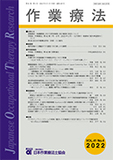Japanese
English
- 販売していません
- Abstract 文献概要
- 1ページ目 Look Inside
- 参考文献 Reference
要旨:本研究の目的は,Bálint症候群を呈した患者1名を対象に日常生活活動(ADL)で用いられる代償手段を明らかにすることとした.事例は左後頭葉出血で急性期病院に入院中の80歳代女性とした.急性期病院入院中に事例のBálint症候群の重症度に変化はなかったが,ADLは向上し,セルフケアが発症から4週間で自立した.向上したADLでは非利き手を用いた視覚的な手がかりと体性感覚による代償手段を用いていた.このことから,Bálint症候群を呈した患者のADLの再獲得には非利き手を用いた視覚的な手がかりと体性感覚を活用した代償手段の練習が有効であると示唆された.
The purpose of this study was to clarify the compensatory methods used for activities of daily living (ADL) in a Bálint syndrome patient. The patient was a woman in her 80s who was admitted to an acute hospital due to left occipital lobe hemorrhage. Although there was no change in the severity of Bálint syndrome during hospitalization, the patient could participate in selfcare activities after 4 weeks from the onset. The visual cues and somatosensory information from the nondominant hand seemed to be utilized in the selfcare activities. Our case report suggests that the practice involving compensatory sensory information at the early stage of Bálint syndrome may be effective to regain ADL.

Copyright © 2022, Japanese Association of Occupational Therapists. All rights reserved.


